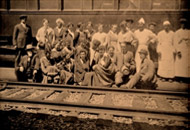1915 — 1920
The Spanish Eclectic style grew as a form that was truer to Spanish architecture than the Mission style had been, with its large parapet roofs and dormers. This style was very rare in the eastern United States, with the exception of Florida, and was found mostly in the southwest, in states like Arizona and Texas. Most examples of this style had a low-pitched roof with little or no overhang and were one or two stories in height. While the house shape varied, most of these structures were asymmetrical in façade with a stucco wall covering and red tile roofs. The most common form that the Spanish Eclectic style building took was that of a cross-gabled roof with at least one front facing gable, or a tall side gabled structure with shorter, flanking wings. Other less common variations included a flat roof form, a hipped roof form, and a version that used a combination of both the hipped roof and the gabled roof.
The Spanish Eclectic style was based on the entire history of Spanish architecture, so many of its decorative elements came from various periods of architectural influence. Elaborate carved doors were Very popular with this style and they were frequently decorated with intricate door surrounds that were often carved or decorated with tile work or spiral columns. Large arched windows were often focal points of the home and many examples in this style had intricate iron grills over them, as well as iron balconies on larger homes. The chimneys of the Spanish Eclectic home usually had decorative tops or tile roofs and it was not uncommon to find decorative vents or tiles in the stucco beneath a roof gable.


Share Your Comments & Feedback: